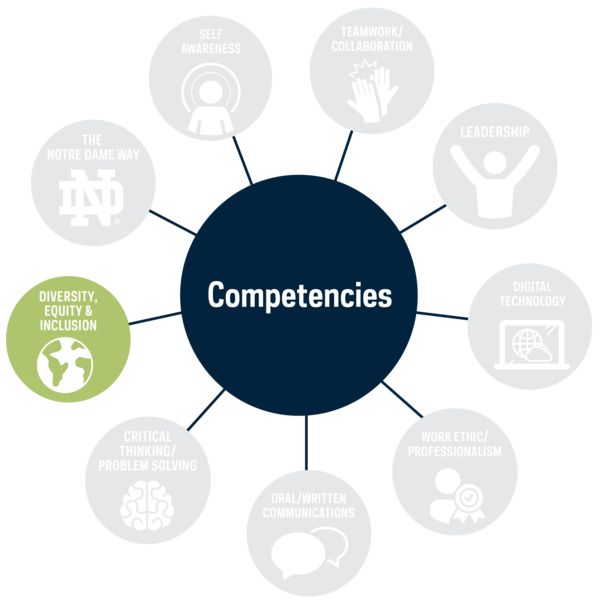Diversity, Equity & Inclusion

Diversity, Equity & Inclusion
Demonstrate openness, inclusiveness, sensitivity, and respectful interaction with all people and continually strive to account for and respect individual differences. Engage in and work to create more inclusive communities, schools, work places, collaborating teams, and agency partnerships to achieve greater fairness of outcomes.
Assessing Your Level of Competency
This is the time to really reflect on yourself and where you are at with this competency. Ask yourself the following questions to dive deep into your self-assessment:
- Have you respectfully participated in a class discussion about a controversial issue?
- When have you made a conscious effort to understand another person's point of view?
- Do you respect cultural differences and preferences among your peers?
- Have you viewed an issue about which you feel strongly from another person's viewpoint?
- Have you joined a student group or club that connects you with peers who do not share all your same views?
- Have you accepted someone else's point of view and perspective in planning/organizing an event?
Building Your Level of Competency
Build on your level of this competency through the following:
- Attend, participate in a cultural activity different than what you've grown up with.
- Instead of responding with your view, ask the other person for more information about their viewpoint.
- We all have biases - we've grown up with them; identify yours. Take the Implicit Bias Test.
- Participate in a study abroad to understand how another country/culture views world events, addresses societal problems.
- Take a Center for Social Concerns class/experience that covers a topic that's uncomfortable for you.
- Engage in a club, group, or team that seeks to include, understand and/or integrate a broad variety of viewpoints, perspectives, and/or beliefs.
- Write a paper analyzing a belief or practice very different than your own.
- Gain fluency in writing, reading and communicating in a non-native language.
- Analyze where disparities correlate with inequitable access to resources - start with a local issue; expand to a global issue.
Communicate this Competency
There are many opportunities to communicate your experience with diversity, equity and inclusion to others; through your resume, cover letters, interviewing, 30-second professional introduction, networking, etc. Consider first ways you have shown your value of ensuring diversity, equity and inclusion for all:
| Understand cultural identity | Demonstrate openness, sensitivity, and inclusiveness with all people |
| Display empathy | Possess knowledge of other cultures |
| Learn from diverse cultures, races, ages, genders, sexual orientations, religions | Examine one's beliefs |
| Understand individuals' differences |
Value and respect diverse cultures, races, ages, genders, sexual orientations, religions |
Then start with statements like the samples below to build upon
- Facilitated a mutually acceptable residence hall visitation policy that met the key factors important to three different student groups.
- Organized a panel of speakers representing opposing viewpoints to promote constructive discussion and critical examination of immigration policy.
- Analyzed the math camp admission process and recommended inclusion of questions that would identify qualified applicants with financial need.
- Translated Arabic news media for daily briefing of the U.S. State Department Embassy staff in Amman, Jordan.
- Interviewed local migrant workers regarding labor conditions to provide a more complete overview to the mayor.
- Co-facilitated dialog session between four student organizations differently impacted by university policy.
Career Ready Competency Tracking Tool
Download the Career Ready Competency Tracking Tool one time from the main Career Competencies webpage, and utilize one document to track the development of all your competencies.